YOU SHOULD SUBSCRIBE TO CLIMATE CHANGE WEEKLY.
IN THIS ISSUE:
- Proposed Virginia Wind Facility Threatens Endangered Whales
- Podcast of the Week: Hurricane Ian Isn’t a Sign of Anthropogenic Climate Change
- Rising Carbon Dioxide Is Boosting Crop Yields, New Studies Confirm
- Models Running Hot, Surface Stations Biased
- Climate Comedy
- Video of the Week: NOAA Hurricane Expert, Heartland Senior Fellow Analyze Hurricane Ian
- BONUS Video of the Week: Is The Climate Cult Crumbling?
- Recommended Sites
Proposed Virginia Wind Facility Threatens Endangered Whales
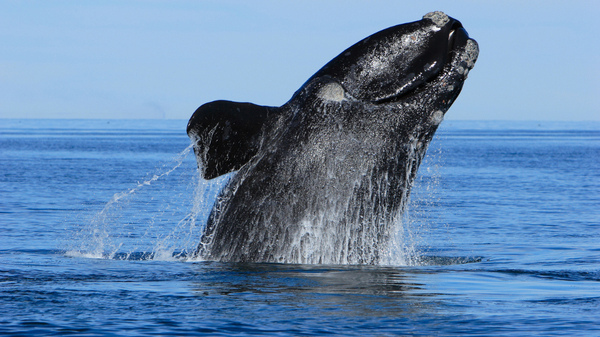
North Atlantic Right Whales (NARW) are majestic giants of the seas. They are the subject of documentaries, scientific research and interest, and popular whale-watching tours. All this, and the whales themselves, could be coming to an end soon, and Democrats, including the Biden administration, are to blame.
There are only approximately 300 NARWs alive today. Various federal laws are supposed to protect the whales. The Endangered Species Act and the Marine Mammal Protection Act, for example, forbid activities that take, seriously harm, or harass the whales or force them out of their critical habitat. If the state of Virginia, Dominion Energy, and the Biden administration have their way, however, NARWs could soon be no more.
The proposed Coastal Virginia Offshore Wind Project is directly in the NARWs’ annual migration path. Dominion Energy has applied to erect 176 wind turbines, covering an area of approximately 10 miles by 15 miles—equal to the size of 85,000 football fields or the city of Tampa, Florida—located 27 miles off the coast of Virginia Beach. Each turbine will sit atop a monopole extending a minimum of 80 feet into the water and about 120 feet into the ocean floor, and its height above the water will top 620 feet. That’s higher than the Washington Monument, which is 555 feet tall.
Fortunately for the whales, a coalition of public interest groups is working to prevent the Biden administration and Democrats in states along the U.S. east coast from filling huge areas of the open seas with monstrously large, noisy, prohibitively expensive wind turbines. The think tank I work for, The Heartland Institute, and the Committee For A Constructive Tomorrow (CFACT) and the American Coalition for Ocean Protection (ACOP) have hired the law firm of Gatzke, Dillon and Ballance (GDB) to represent them in evaluating the upcoming draft Environmental Impact Statement (EIS) the Bureau of Ocean Energy Management (BOEM) is producing for the Coastal Virginia Offshore Energy Project which is to be managed and constructed by Dominion Energy.
In a series of articles published by CFACT, David Wojick, Ph.D. has described in detail why the Coastal Virginia Offshore Wind Project is almost certain to cause the extinction of the NARW.
“How to kill whales with offshore wind?” Wojick asks. “Just push them into traffic. The collision deaths would not be directly attributable to the wall of noise created by the OSW project, so who would know?”
Whales are highly sensitive to sound, which they use to navigate. The subsea infrasound and vibrations generated by the turbines are virtually guaranteed to force the few remaining NARWs out of their critical migration routes and into one of the busiest shipping corridors in the world. This will make a bad situation worse: ship collisions are already the largest single cause of NARW mortality. Even if the whales somehow prove able to adapt to and tolerate the sound, the undersea monopoles will pose new navigation hazards for them.
What does Dominion have to say about the threat to protected whales and other species? It’s impossible to tell from its official filings. As Wojick reports, Dominion has hidden the research and data about the project’s possible effect on NARWs.
“Digging into Dominion’s filing with BOEM I found … Dominion has done an actual threat assessment but it is 100% secret!” writes Wojick. “This is outrageous.” The BOEM is one of the agencies that has to review and approve the project.
Wojick notes the BOEM has a separate website devoted to the Costal Virginia Offshore Wind Project, which includes Construction and Operations Plan (COP) documents from Dominion. Even there, on an official government website, it does not state what effects the project might have on ocean life such as the endangered NARW.
The long main report contains 32 technical appendices, including “Appendix R: Threatened and Endangered Species Review.” When Wojick opened Appendix R, however, there was no discussion of the potential effects the project might have on the severely endangered NARW and other threatened and endangered species, nor of what Dominion might do to minimize any adverse impact. Instead, he found a single page stating, “Proprietary and Confidential Business Information Exempt from Public Disclosure.”
“That is all there is to Appendix R. It is 100% secret,” writes Wojick. “Even the number of pages is not disclosed, as it is with the other Appendices, that one can actually read.”
So much for the Biden administration’s supposed commitment to transparency.
“That this assessment is kept secret is outrageous all by itself, but it also raises a much deeper issue,” writes Wojick. “Will the BOEM Environmental Impact Assessment also include secret science?”
Good question. Dominion’s proposed wind project is not the first to come under heightened scrutiny from groups concerned about sea life and traditional ocean activities. Commercial fishing groups have organized to oppose a huge offshore wind project 12 nautical miles off the coast of Martha’s Vineyard, Massachusetts. They point out by the government’s own statements, the project is likely to harm sea life in the area and the shipping hazards caused by the turbines will probably result in a huge swath of traditional fishing grounds being placed off-limits to commercial fishing.
GDB currently represents plaintiffs in federal lawsuits challenging the New York Bight offshore wind project off the coast of New York and New Jersey, as well as the Vineyard Wind project off the southern shore of Martha’s Vineyard.
Industrial wind facilities’ harmful effects on wildlife are not limited to offshore projects, as thousands of birds and bats are killed each year by wind turbines. The legal protections afforded by various state and federal laws have not prevented the wholesale slaughter of these avian species. Only time, and perhaps lawsuits, will determine whether the laws protecting whales do any better for them than those protecting birds and bats have done.
When it comes to politically favored industrial wind and solar facilities, animals are no more secure in their homes than Native American tribes were in theirs when, despite treaties promising some area or another would be theirs for as long as the sun shinned and the river flowed, the government decided it wanted their land or its resources after all. The fetishistic pursuit of wind power at the expense of every other goal is the new “manifest destiny,” and it is just as deadly to living beings in its way.
“Unless BOEM requires extensive, effective, unprecedented protection measures for the North Atlantic right whale immediately, this species is almost certainly headed toward extinction,” said ACOP President David Stevenson in a press release announcing the coalition’s hiring of GDB to examine the impact of Dominion’s offshore wind project on the whales and the cost of the project to consumers. “With only a little more than 300 individual right whales alive today, this endangered species is in dire need of protection, and the Virginia Wind Project lies directly in their annual migration path. The project will require extensive daily maintenance by multiple service ships, and the potential for whale fatalities due to ship strikes is indisputable.”
CFACT President Craig Rucker says the threat to whales is not the only thing that should cause environmentalists to remove their green label of approval from this project.
“We are not only very concerned about the future of the right whale … but also concerned as to how BOEM will address the fact that this project, despite its alleged benefits regarding carbon dioxide and climate change, will actually cause the release of more carbon dioxide into the atmosphere than it will consume,” said Rucker in a press release.
Heartland Institute President James Taylor argues the offshore wind project should receive at least as much scrutiny as fossil fuel projects have.
“Before construction commences, the project should be given the same level of scrutiny for environmental protection by the courts and the federal authorities as has been provided for fossil fuel projects in Virginia, such as the Mountain Valley Pipeline,” said Taylor.
Dominion Energy, electric power users in Virginia, and the climate will survive if this industrial offshore wind facility fails to get approval. The same cannot be said for the North Atlantic Right Whale.
SOURCES: Heartland Daily News; CFACT; The Heartland Institute
Podcast of the Week
H. Sterling Burnett joins the John Steigerwald Show to discuss the corporate media’s use of Hurricane Ian to push their alarmist narrative. Rather than show sympathy for those affected by this extreme weather event, media pundits such as Don Lemon on CNN are using the moment to try and scare Americans into relinquishing their liberty in order to fight the false threat of human induced climate change. Burnett sets the record straight.
Subscribe to the Environment & Climate News podcast on Apple Podcasts, iHeart, Spotify or wherever you get your podcasts. And be sure to leave a positive review!
Get your Copy at Amazon TODAY!
Rising Carbon Dioxide Is Boosting Crop Yields, New Studies Confirm
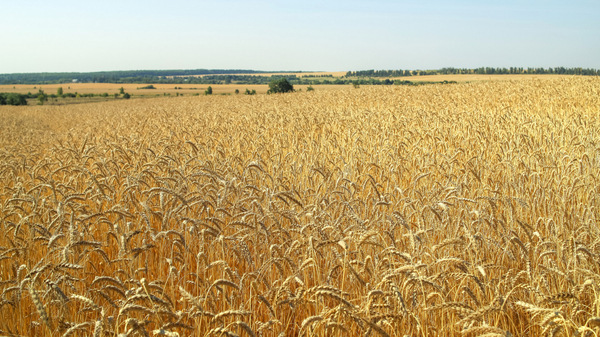
Recent research published in the European Physical Journal Plus confirms what previous studies have shown: gross primary production of all plants, including grasses, trees, flowers, and key cereal crops, increased by more than 30 percent during the twentieth century. For staple crops such as maize (corn), rice, soybean, and wheat, yields have increased by approximately 3 percent per year since 1961.
The team of scientists from a variety of universities and research institutes in Italy set out to review the recent literature on the measurable effects of climate change on a variety of types of weather event trends and the productivity of plants.
Regarding the former, their trend analysis found no discernible effect of climate change on hurricanes and tornadoes or climate disasters such as floods and droughts:
The analysis is then extended to some global response indicators of extreme meteorological events. …. None of these response indicators show a clear positive trend of extreme events. In conclusion on the basis of observational data, the climate crisis that, according to many sources, we are experiencing today, is not evident yet.
By contrast, the study finds the effect of higher carbon dioxide levels is clear and positive:
[I]t can be said that global plant biomass has changed significantly in recent decades with a phenomenon known as global greening which indicates the significant increase in productivity of ecosystems (agricultural and natural) that in recent decades was mainly highlighted by satellite monitoring.
Satellite data show “greening” trends over much of the planet … are pushing back deserts around the world (both hot deserts of tropical latitudes and cold deserts of more northern latitudes) … [and] show a 31 percent increase in gross primary production during the twentieth century.
The paper, and an article in Climate-Science Press discussing it, cite multiple recent studies indicating a primary cause of the greening is the increase in atmospheric carbon dioxide (CO2), with as much as a 50 percent increase in photosynthesis and a more than 25 percent rise in crop yields being attributable solely to elevated CO2.
Should carbon dioxide double from preindustrial levels, the increase in gross primary productivity would rise from the present 30 percent to 50 percent, the study found.
SOURCES: Climate-Science Press; European Physical Journal Plus; The Epoch Times
Heartland’s Must-read Climate Sites
Models Running Hot, Surface Stations Biased
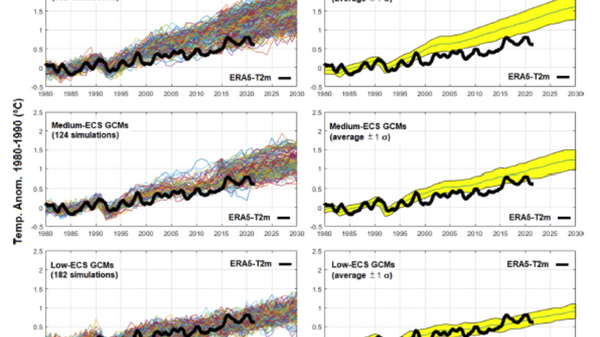
New research published in the journal Climate Dynamics examines estimates of climate sensitivity (ECS) built into 38 of the latest-generation climate models—the Coupled Model Intercomparison Project, phase 6 (CMIP6)—and finds they vastly overstate the amount of warming, when comparing their projections with real-world measurements by ground-based monitoring systems and satellites.
The paper points out the model-estimated temperatures from a doubling of carbon dioxide range from 1.8 to 5.7 ◦C IPCC (2021), calling the large range of possible values “highly problematic as it indicates that the climate system is still poorly understood and modeled.” As a result, “the extent of future climate change is rather uncertain as the impact of anthropogenic CO2 emissions on the climate cannot yet be adequately quantified.”
In a hindcasting exercise, the researchers tested the accuracy and precision of the models in high, medium, and low emission scenarios against the mean global surface temperatures recorded from 1980 through 1990 and from 2011 through 2021 from a variety of global datasets, and to satellite measurements of temperatures for the same time periods. Their results are clear:
We found that the medium and high-ECS GCMs run too hot up to over 95% and 97% of cases, respectively. The low ECS GCM group agrees best with the warming values obtained from the surface temperature records, ranging between 0.52℃ and 0.58℃. However, when comparing the observed and GCM hindcasted warming on land and ocean regions, the surface-based temperature records appear to exhibit a significant warming bias. Furthermore, if the satellite based UAH-MSU-lt record is accurate, actual surface warming from 1980 to 2021 may have been around 0.40℃ (or less), that is up to about 30% less than what is reported by the surface-based temperature records.
The latter situation implies that even the low-ECS models would have produced excessive warming from 1980 to 2021. These results suggest that the actual ECS may be relatively low, i.e. lower than 3℃ or even less than 2℃ if the 1980–2021 global surface temperature records contain spurious warming, as some alternative studies have already suggested. Therefore, the projected global climate warming over the next few decades could be moderate and probably not particularly alarming.
A recent study from The Heartland Institute confirms what this study suggests about the ground-based temperature recording system: that the data they provide is biased by poor siting.
SOURCES: Climate Dynamics; The Heartland Institute
Video of the Week: NOAA Hurricane Expert, Heartland Senior Fellow Analyze Hurricane Ian
Stanley Goldenberg is a meteorologist with NOAA/AOML’s Hurricane Research Division. He joined Heartland Institute Senior Fellow Anthony Watts for a live analysis of Hurricane Ian as the storm made landfall on Wednesday. Watts and Goldenberg discuss developments as they occur, cover a viral clip of Don Lemon getting shut down by the acting director of the National Hurricane Center, and explain the science behind hurricanes.
BONUS Video of the Week: Is The Climate Cult Crumbling?
The Heartland Institute’s Donald Kendal, Jim Lakely, and Chris Talgo present episode 365 of the In The Tank Podcast. Stories have popped up recently that might point to the climate cult falling apart. From Al Gore calling out corporations for “greenwashing” to Rashida Tlaib lashing out at bankers for not cutting off fossil fuel financing, it seems like the “greenies” are turning on each other. Also, YouTube denied our attempt at monetizing our channel, claiming our content is “harmful.”
Tune in EVERY FRIDAY at noon CT for another LIVE episode of Climate Change Roundtable.


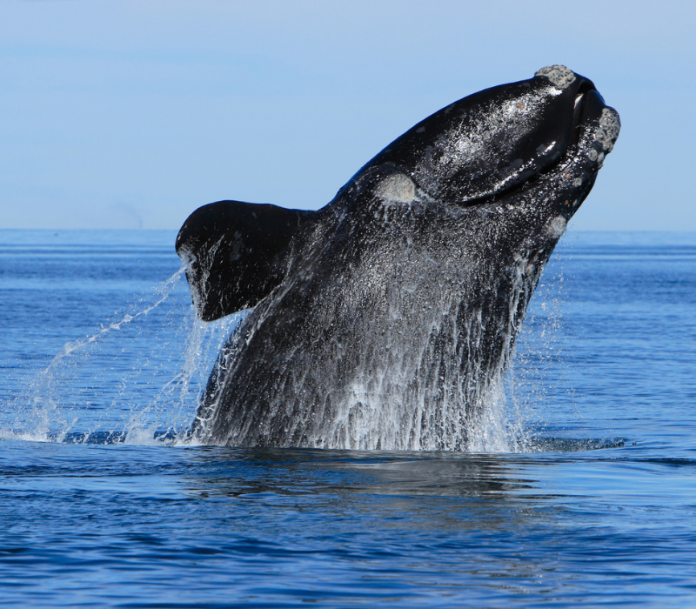
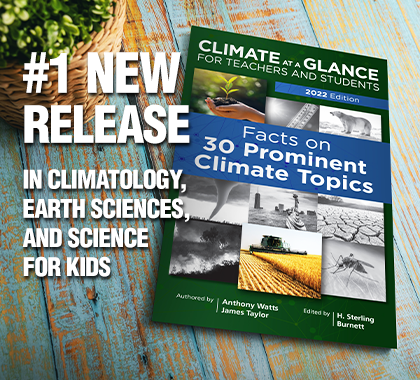



























The press and the global warming crowd deliberately suppress the fact that ANTARCTICA has had record cold, snow and ice accumulation for decades. Even the last few years, ANTARCTICA cold, snow and ice have hit record numbers. The number of catastrophic hurricanes and tornadoes has dwindled the last couple of decades. The oceans have not risen appreciably other than the normal waxing and waning of ice melt and evaporation cycles. If you try to google it, the first few pages will be pro global warming but when you drill down to the more reputable “scientific” sites it says no global warming. Also droughts, cold snaps, and weather extremes are the rule all throughout recorded history. There are records clear back to the 1400’s verifying this fact. One has to dig for this data because the political and globalists agenda has big-tech, the leftist media, et al working at sequestering real facts as the “Brown Shirts” did for Hitler. Most folks don’t even go past the first page and these hyena Globalists at google know this.
Lastly, look up the sun-spot cycle which is an eleven year cycle. The weather patterns on earth are affected profoundly by this cycle.
They try to explain it away with all kinds of mental gymnastics but it doesn’t pass the smell test. Funny one never hears of this, but then again suppression of reality by ideologues is commonplace.
P.S. the so-called doomed Great Barrier Reef is thriving and growing.
[…] Sources: Climate Change Weekly; International Energy Agency; Bureau of Ocean Energy Management […]